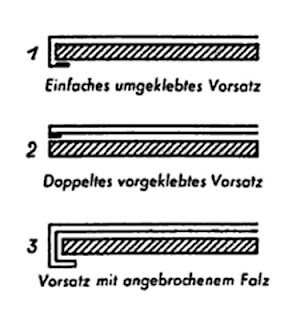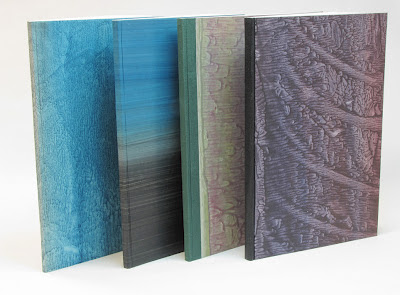
Showing posts with label History of the Trade. Show all posts
Showing posts with label History of the Trade. Show all posts
Sunday, May 10, 2015
Werbung - Julius Hager, Leipzig
Advertisement for Julius Hager, Leipzig from the Deutsche Einbandkunst catalog edited and produced by Ernst Collin for the Jakob-Krauße-Bund, 1921.


Saturday, November 29, 2014
Stenciled Papers
Received a copy of August Weichelt's Buntpapier-Fabrikation (3rd ed, 1927), and was elated to find a mention for Ernst Collin in the introduction that credited him with writing a new section on Java Art Papers (Java Kunstpapiere), also known as batik papers. In with Collin's section, this page of commercially made stenciled papers.
While Weichelt gives a nod to hand-made decorated papers, it is really about the industrial manufacture of these. As such, the book goes into many different printing processes, equipment, and similiar. It is richly illustrated with hundreds of tipped-in samples. The page above was not in the earlier editions. A digital version of the 2nd edition (1911) can be found online in the HathiTrust collections. Hathi version only available to those in US.
While Weichelt gives a nod to hand-made decorated papers, it is really about the industrial manufacture of these. As such, the book goes into many different printing processes, equipment, and similiar. It is richly illustrated with hundreds of tipped-in samples. The page above was not in the earlier editions. A digital version of the 2nd edition (1911) can be found online in the HathiTrust collections. Hathi version only available to those in US.
Sunday, November 16, 2014
Fritz Eberhardt - Three Lectures
Don Rash and his Boss Dog Press have just published the second title in a series of Eberhardtiana, the first having been 2003's Rules for Bookbinders. Rules is an "unfinished poem written in German and English
before Fritz's death. The stanzas were lettered so that each stanza is
presented in both languages on a page, separated by a sketch by Fritz." Sold out at the press, a copy is still available at Oak Knoll Books.
Three Lectures is a compilation of three lectures given by Fritz Eberhardt. The first, "On Binding" was delivered at the opening of Hand Bookbinding Today; An International Art, at Temple University in Philadelphia in 1978. The second, "Preserving the Materials of a Heritage" was given at a 1981 seminar. In it, Eberhardt talks about the book conservation challenges he and his wife faced after settling in the Philadelphia area in the mid-1950s. The third is "Bookbinding: The Craft, The Skill, The Trade, and The Art" given 1983 at the "Art and Craft of the Book: A Celebration" seminar held at Dickinson College.
Three Lectures is printed on Frankfurt Laid paper in Linotype digital Aldus and Don Rash's own "experimental" blackletter font FritzGotische for the title and headings. The frontispiece was printed as a moku hanga woodblock print by Rash after a photograph in John & Mary's Journal by A. Pierce Bounds where the third lecture was originally published. The case binding is covered in a pastepaper with printed paper labels on spine and front board. An example of gediegene and zünftige (solid and befitting the craft/trade) bookbinding in the finest German tradition.
Eberhardt was also the focus of an oral history recorded in 1993 by archivist Valerie Metzger that was published in the Guild of Book Workers' Journal, volume XXXVII, number 2, Fall 2002. This article is a must-read for those interested in the work of Eberhardt and the traditions and circumstances of bookbinding in Germany during the 1930s and 40s, but also for those working in the book arts. The introduction shared via the Guild listserv can be read here. Eberhardt was also the focus of an illustrated article "Binds That Time: Homage to a Master Bookbinder" by Tony Haverstick, published in the June 1998 (vol 3, nr. 6) issue of the now defunct Biblio magazine. Here a link to his obituary from the Abbey Newsletter at CoOL.
Don Rash's Eberhardtiana series pays very fitting homage to his Meister, and mentor, Fritz Eberhardt. These lectures are as relevant today as when they were given over 30 years ago, and touch on all aspects of the life of private practice bookbinders, book artists, and conservators.
Three Lectures is a compilation of three lectures given by Fritz Eberhardt. The first, "On Binding" was delivered at the opening of Hand Bookbinding Today; An International Art, at Temple University in Philadelphia in 1978. The second, "Preserving the Materials of a Heritage" was given at a 1981 seminar. In it, Eberhardt talks about the book conservation challenges he and his wife faced after settling in the Philadelphia area in the mid-1950s. The third is "Bookbinding: The Craft, The Skill, The Trade, and The Art" given 1983 at the "Art and Craft of the Book: A Celebration" seminar held at Dickinson College.
Three Lectures is printed on Frankfurt Laid paper in Linotype digital Aldus and Don Rash's own "experimental" blackletter font FritzGotische for the title and headings. The frontispiece was printed as a moku hanga woodblock print by Rash after a photograph in John & Mary's Journal by A. Pierce Bounds where the third lecture was originally published. The case binding is covered in a pastepaper with printed paper labels on spine and front board. An example of gediegene and zünftige (solid and befitting the craft/trade) bookbinding in the finest German tradition.
- Eberhardt, Fritz. Three Lectures. Plains, PA: Boss Dog Press, 2014.
- 8vo. paper-covered boards, labels on spine and front cover, top edge cut, other edges uncut iv, 39+(1) pages
- Limited to 100 numbered copies, 70 numbered and signed by Don Rash.
- Price: $250.00
- Copies in sheets for binding may also be available from the press.
Eberhardt was also the focus of an oral history recorded in 1993 by archivist Valerie Metzger that was published in the Guild of Book Workers' Journal, volume XXXVII, number 2, Fall 2002. This article is a must-read for those interested in the work of Eberhardt and the traditions and circumstances of bookbinding in Germany during the 1930s and 40s, but also for those working in the book arts. The introduction shared via the Guild listserv can be read here. Eberhardt was also the focus of an illustrated article "Binds That Time: Homage to a Master Bookbinder" by Tony Haverstick, published in the June 1998 (vol 3, nr. 6) issue of the now defunct Biblio magazine. Here a link to his obituary from the Abbey Newsletter at CoOL.
 |
| Binding covered in original pastepaper Click here to see how the pastepaper was made on the Boss Dog Press blog |
 |
| Moku hanga woodblock print by Don Rash |
 |
| Photograph in John & Mary's Journal by A. Pierce Bounds |
Don Rash's Eberhardtiana series pays very fitting homage to his Meister, and mentor, Fritz Eberhardt. These lectures are as relevant today as when they were given over 30 years ago, and touch on all aspects of the life of private practice bookbinders, book artists, and conservators.
Friday, July 18, 2014
Renate Mesmer on her Apprenticeship in Germany
 |
| Renate at AAB |
Previously, she was Assistant Head of Conservation at the Folger, Director of Book and Paper Conservation at the Centro del bel Libro Ascona, Switzerland, and Head of Conservation at the Speyer’s State Archives in Germany. She, like many apprentices of the day started at age 16, earning her Meister in bookbinding from the Chamber of Crafts of Palatinate in Germany. She has been very active teaching at Paper and Book Intensive (PBI), for the Guild of Book Workers (GBW), American Academy of Bookbinding (AAB), and elsewhere.
Sunday, January 26, 2014
Conrad Blum, Buchbinder
A month or so ago, via eBay, I acquired this bill from the bookbinder Conrad Blum in Offenbach dated 21 October, 1842. Offenbach at that time was part of the Grand Duchy of Hessen and is now considered part of the Frankfurt (Main) metropolitan area.
Although fluent in German, the handwriting style of the time is not my strong point. I'm also not sure what currency is being referred to (Gulden or Thaler), especially as the Customs Union (Zollverein) led by Prussia was growing in member states at that time. A more contemporary comparison would be the expansion of the Eurozone... Hessen-Darmstadt of which Offenbach was a part joined in 1837.
A high-resolution PDF of the bill has been saved here. Any assistance in transcribing VERY welcome.
Although fluent in German, the handwriting style of the time is not my strong point. I'm also not sure what currency is being referred to (Gulden or Thaler), especially as the Customs Union (Zollverein) led by Prussia was growing in member states at that time. A more contemporary comparison would be the expansion of the Eurozone... Hessen-Darmstadt of which Offenbach was a part joined in 1837.
A high-resolution PDF of the bill has been saved here. Any assistance in transcribing VERY welcome.
Monday, December 23, 2013
Reference Collection Development
Interesting collection of reading material arrived in my reference library
over the past month or so…
First, two titles by Paul Adam. The first is Lehrbücher der Buchbinderei: Die einfachen handwerksmässigen Buchbinderarbeiten ohne Zuhilfenahme von Maschinen (1924) a thin manual describing the most basic and essential tasks to be completed in a bindery leaving out machines. (boardshears and presses don’t count). Obviously written for apprentices, this one came from the public library in Bayreuth and showed a fairly active circulation in the first decade of it’s life. Then came the war… Paper not great, but lots of provenance. It’s also the kind of title that would have been in every proper trade school library and larger bindery. Needs some TLC, but then there is the bit about the shoemakers kids (and I had 7 generations of master shoemakers in my family)…
The other Adam title in this batch is Die deutscheste Art der Einbandverzierung (1928), a Festschrift for the 47th gathering of the Bundes Deutscher Buchbinder-Innungen. Not sure why it was the titled “the most German of binding decoration techniques” (tooling), but looks to be an interesting read. That was “bound” into a simple card wrapper… Like the one above, needs some TLC to make sure the single leaves don’t fall out.
Next up E(rich) A(dolf) Bogeng’s Der Bucheinband: ein Handbuch für Buchbinder und Bücherfreunde (1940). Title translated is Bookbinding: a handbook for bookbinders and bibliophiles. It’s an interesting overview of the book and book/trade history broken down into by general history; structural elements; decorative techniques; binders and bibliophiles, … I found the arrangement the interesting part – there are no illustrations. Bogeng was one of THE German writers about bookbinding and bibliophilic culture in the late 19th, first half of the 20th century. This one was reprinted in several editions.
I also acquired two volumes of Der Buchbinderlehrling (The Bookbinding Apprentice) a “journal” published for apprentices in Germany, Austria, and Switzerland by the Allgemeiner Anzeiger für Buchbindereien, the trade publication late 19th century and most of the 20th century. A journal like this was a bridge to trade school that continued the overall education of the young apprentices because they were dropped from the university-bound track. Subjects included social studies, math, and science as they related to binding. This also included paper making, leather tanning and parchment making, cloth, and in-depth engineering of bookbinding machines...
Years I received were 1932 and 1938 with 12 issues each. Quite a contrast between the two.
First in 1932, an article by Ernst Collin and the first in a series titled Bedeutende Männer des Buchbinderhandwerks (Important Men in Bookbinding) – the subject, Ernst's father Georg Collin, Court Bookbinder who died in 1918. Ernst' Der Pressbengel was dedicated to him. While most of Collin’s writing is academic, this was written with a much more casual tone making it more accessible for apprentices. There was also a multi-part article on gold tooling by Walter Gerlach (1892 – 1982). Trying to find out if there was a connection between him and Gerhard Gerlach. Gerhard Gerlach married Kathryn Edwards, and both studied with Wiemeler in Leipzig in the early 30s. There were also two tipped-in cards with material samples and articles on how to use those, a nice article about the life and impact of Roger Payne (illustrated by the engraving of him hunched over a press), and one telling soon to be journeymen that despite the fact that most would be unemployed after completing their apprenticeship, that they should remain hopeful and engaged. Also an interesting, ongoing series about architectural styles and history.
1938 was quite a change, and it was clear who was now running the country. Oddly, issue 1 from 1933 had been bound in instead of 1938... The volume had an article on fish leather, Igraf (a cellulose-based ersatz paper/parchment with the look of Elephant Hide, a paper now produced by Zanders, and a longer article by Franz Weisse on marbling. This contained the same illustrations as his work about marbling that was republished by Richard J. Wolfe as The Art of Marbling (Wolfe also had some things to say about the politics of the time). To round it out, articles on the need to bring bookbinding (and all the trades) into the nationalistic fold, competitions for apprentices and journeymen, depictions of bindings extolling the virtues of the Führer and Party… One image showed Otto Dorfner, Hugo Wagner, and Franz Weisse jurying bindings, some with their party pins in place… Below another from a national trades meeting. The "youth" of the trades are being addressed...
Buchatelier Bischoff in German is reprinting the complete run of the Buchbinderlehrling (1927 – 1944) on a subscription basis, every two months a new year... I already received 1927. No Ernst Collin articles, but several by Maria Luers, the first woman bookbinding Meister in Germany. This is going to be fun. They also republish many other classic German binding titles in sheets or bound. Check them out.
Almost as a logical follow-up to the 1938 issue above, a nice catalog Ausstellung Malerei, Graphik, Buchkunst (1955) that featured bindings by Otto Dorfner in addition to the prints and paintings by two other artists. Dorfner worked largely in Weimer, a town that ended up in the Soviet Occupation Zone after the war, what became the German Democratic Republic (DDR). Stylistically, the binding shown continue the strong German style of design and tooling that was also used by Wiemeler…. Interestingly, in addition to books by Goethe, there are also bindings on works by Stalin, Karl Marx, Ernst Thälman, Wilhelm Pieck, … Communists, Soviets, and East German leaders all.
I think that there is a post/article in there about politics and the trade(s). Just need to line up some visuals (have lots in various books) and try to find some examples elsewhere. I could start it off with a "song" sung at the German Bookbinder's Assembly in Berlin in which the formation of the German Empire in 1871 is described in the context of binding a book... Designer Bookbinders had a 2008 exhibition Socialism: A Celebration in which binders selected historically significant socialist texts from the collection of Lord Tom Sawyer of Darlington, but that exhibition was not about the bookbinding trade in the service of a particular ruling ideology. There is also a rich history of Marxist (and other) children's books, but that's not design bookbinding either... If anyone has any examples I'd love to hear about them.
Another book was the 1995 Festschrift of the Buchbinder-Innung (Guild) Berlin-Brandenburg. Lots of interesting details about the trade in Berlin over 400 years also indicating some differences with the Verein Berliner Buchbindermeister (Organization of Master Bookbinders in Berlin) whose Chronik I also own, and that provided lots of good information on the Collins. Some of the differences apparently center on Maria Lühr (first woman to learn the trade under Georg Collin and Joseph Zaehnsdorf, and first female Meister in Germany), the role of women in the trade and training, and the Lette Verein, an organization for women that taught trades. It still exists.
I had long had a copy of Lawrence S. Thompson's Kurze Geschichte der Handbuchbinderei in den vereinigten Staaten von Amerika (Stuttgart: Max Hettler, 1955), and given that Thompson was American working at the University of Kentucky Library was perplexed to not find the title available in English. That changed this week when I received A Short History of Bookbinding in the United States by Lawrence S. Thompson. From the dealer copy:
Thompson's titles contain much information of interest (in particular to me) on German-trained binders in the US. Many of those named were indicated as being members of the Guild of Book Workers, too. He also published Fine Binding In America, The Story Of The Club Bindery, but that is a different book. A Short History... concluded with "Even in the atomic age, hand bookbinding will have a strong place in the culture of the United States." Thoughts?
The interlibrary loan department at Syracuse also came through with some articles by Ernst Collin from 1934-36, and one about the Collins' as Hofbuchbinder that also mentioned Ernst from the 1947 (all from the Allgemeiner Anzeiger für Buchbindereien). VERY glad to have those.
First, two titles by Paul Adam. The first is Lehrbücher der Buchbinderei: Die einfachen handwerksmässigen Buchbinderarbeiten ohne Zuhilfenahme von Maschinen (1924) a thin manual describing the most basic and essential tasks to be completed in a bindery leaving out machines. (boardshears and presses don’t count). Obviously written for apprentices, this one came from the public library in Bayreuth and showed a fairly active circulation in the first decade of it’s life. Then came the war… Paper not great, but lots of provenance. It’s also the kind of title that would have been in every proper trade school library and larger bindery. Needs some TLC, but then there is the bit about the shoemakers kids (and I had 7 generations of master shoemakers in my family)…
 |
| Illustration from Adam, Lehrbücher der Buchbinderei: Die einfachen handwerksmässigen Buchbinderarbeiten ohne Zuhilfenahme von Maschinen (1924) |
The other Adam title in this batch is Die deutscheste Art der Einbandverzierung (1928), a Festschrift for the 47th gathering of the Bundes Deutscher Buchbinder-Innungen. Not sure why it was the titled “the most German of binding decoration techniques” (tooling), but looks to be an interesting read. That was “bound” into a simple card wrapper… Like the one above, needs some TLC to make sure the single leaves don’t fall out.
Next up E(rich) A(dolf) Bogeng’s Der Bucheinband: ein Handbuch für Buchbinder und Bücherfreunde (1940). Title translated is Bookbinding: a handbook for bookbinders and bibliophiles. It’s an interesting overview of the book and book/trade history broken down into by general history; structural elements; decorative techniques; binders and bibliophiles, … I found the arrangement the interesting part – there are no illustrations. Bogeng was one of THE German writers about bookbinding and bibliophilic culture in the late 19th, first half of the 20th century. This one was reprinted in several editions.
I also acquired two volumes of Der Buchbinderlehrling (The Bookbinding Apprentice) a “journal” published for apprentices in Germany, Austria, and Switzerland by the Allgemeiner Anzeiger für Buchbindereien, the trade publication late 19th century and most of the 20th century. A journal like this was a bridge to trade school that continued the overall education of the young apprentices because they were dropped from the university-bound track. Subjects included social studies, math, and science as they related to binding. This also included paper making, leather tanning and parchment making, cloth, and in-depth engineering of bookbinding machines...
Years I received were 1932 and 1938 with 12 issues each. Quite a contrast between the two.
First in 1932, an article by Ernst Collin and the first in a series titled Bedeutende Männer des Buchbinderhandwerks (Important Men in Bookbinding) – the subject, Ernst's father Georg Collin, Court Bookbinder who died in 1918. Ernst' Der Pressbengel was dedicated to him. While most of Collin’s writing is academic, this was written with a much more casual tone making it more accessible for apprentices. There was also a multi-part article on gold tooling by Walter Gerlach (1892 – 1982). Trying to find out if there was a connection between him and Gerhard Gerlach. Gerhard Gerlach married Kathryn Edwards, and both studied with Wiemeler in Leipzig in the early 30s. There were also two tipped-in cards with material samples and articles on how to use those, a nice article about the life and impact of Roger Payne (illustrated by the engraving of him hunched over a press), and one telling soon to be journeymen that despite the fact that most would be unemployed after completing their apprenticeship, that they should remain hopeful and engaged. Also an interesting, ongoing series about architectural styles and history.
1938 was quite a change, and it was clear who was now running the country. Oddly, issue 1 from 1933 had been bound in instead of 1938... The volume had an article on fish leather, Igraf (a cellulose-based ersatz paper/parchment with the look of Elephant Hide, a paper now produced by Zanders, and a longer article by Franz Weisse on marbling. This contained the same illustrations as his work about marbling that was republished by Richard J. Wolfe as The Art of Marbling (Wolfe also had some things to say about the politics of the time). To round it out, articles on the need to bring bookbinding (and all the trades) into the nationalistic fold, competitions for apprentices and journeymen, depictions of bindings extolling the virtues of the Führer and Party… One image showed Otto Dorfner, Hugo Wagner, and Franz Weisse jurying bindings, some with their party pins in place… Below another from a national trades meeting. The "youth" of the trades are being addressed...
Buchatelier Bischoff in German is reprinting the complete run of the Buchbinderlehrling (1927 – 1944) on a subscription basis, every two months a new year... I already received 1927. No Ernst Collin articles, but several by Maria Luers, the first woman bookbinding Meister in Germany. This is going to be fun. They also republish many other classic German binding titles in sheets or bound. Check them out.
 |
| Another image from the 1938 volume. Notice anything peculiarly practical? |
Almost as a logical follow-up to the 1938 issue above, a nice catalog Ausstellung Malerei, Graphik, Buchkunst (1955) that featured bindings by Otto Dorfner in addition to the prints and paintings by two other artists. Dorfner worked largely in Weimer, a town that ended up in the Soviet Occupation Zone after the war, what became the German Democratic Republic (DDR). Stylistically, the binding shown continue the strong German style of design and tooling that was also used by Wiemeler…. Interestingly, in addition to books by Goethe, there are also bindings on works by Stalin, Karl Marx, Ernst Thälman, Wilhelm Pieck, … Communists, Soviets, and East German leaders all.
I think that there is a post/article in there about politics and the trade(s). Just need to line up some visuals (have lots in various books) and try to find some examples elsewhere. I could start it off with a "song" sung at the German Bookbinder's Assembly in Berlin in which the formation of the German Empire in 1871 is described in the context of binding a book... Designer Bookbinders had a 2008 exhibition Socialism: A Celebration in which binders selected historically significant socialist texts from the collection of Lord Tom Sawyer of Darlington, but that exhibition was not about the bookbinding trade in the service of a particular ruling ideology. There is also a rich history of Marxist (and other) children's books, but that's not design bookbinding either... If anyone has any examples I'd love to hear about them.
Another book was the 1995 Festschrift of the Buchbinder-Innung (Guild) Berlin-Brandenburg. Lots of interesting details about the trade in Berlin over 400 years also indicating some differences with the Verein Berliner Buchbindermeister (Organization of Master Bookbinders in Berlin) whose Chronik I also own, and that provided lots of good information on the Collins. Some of the differences apparently center on Maria Lühr (first woman to learn the trade under Georg Collin and Joseph Zaehnsdorf, and first female Meister in Germany), the role of women in the trade and training, and the Lette Verein, an organization for women that taught trades. It still exists.
I had long had a copy of Lawrence S. Thompson's Kurze Geschichte der Handbuchbinderei in den vereinigten Staaten von Amerika (Stuttgart: Max Hettler, 1955), and given that Thompson was American working at the University of Kentucky Library was perplexed to not find the title available in English. That changed this week when I received A Short History of Bookbinding in the United States by Lawrence S. Thompson. From the dealer copy:
This is from a most curious assembled typescript I just bought, "with pp. 1-12 (and possibly an unnumbered 13th page following) provided in original typescript, pp. 11-34 (continuing the text uninterrupted, though in a different type font) provided in facsimile/photocopy, all printed on recto only. The latter portion shows several stamps from the University of Kentucky Libraries and various corrections to the typescript, so we are tempted to assume that it may be a copy."I was able to confirm that this is the original English of an article published in/for Germany. I couldn't find an English version of my "unpublished" typescript, OCLC shows that just at the University of Kentucky where Thompson was Librarian. Vito J. Brenni's bibliography Bookbinding, a guide to the literature indicates that this was published in English as Some Notes on the History of Bookbinding in the United States, American Book Collector, Vol 7, Nos 5-7, Jan-Mar, 1955. Still trying to find a copy though... Interestingly found what seems to be an abridged version of the article in a journal - Hand Bookbinding in the United States Since the Civil War, Libri, Vol 5, no 2, 1954 (97-121)
Thompson's titles contain much information of interest (in particular to me) on German-trained binders in the US. Many of those named were indicated as being members of the Guild of Book Workers, too. He also published Fine Binding In America, The Story Of The Club Bindery, but that is a different book. A Short History... concluded with "Even in the atomic age, hand bookbinding will have a strong place in the culture of the United States." Thoughts?
The interlibrary loan department at Syracuse also came through with some articles by Ernst Collin from 1934-36, and one about the Collins' as Hofbuchbinder that also mentioned Ernst from the 1947 (all from the Allgemeiner Anzeiger für Buchbindereien). VERY glad to have those.
Thursday, October 31, 2013
Bindings by W. Collin
Syracuse University Libraries' Leopold v. Ranke Collection can be considered as a time-capsule of sorts in that all books were bound before 1888 when the collection came to Syracuse to form the core of the new university library, largely as a circulating collection. Exceptions are (few) volumes that were rebound by library binders and conservation rebinds/treatments completed after the conservation lab was established in 1995 by me as a part of a grant funded project.
"Leopold von Ranke (1795-1886), a German historian and historiographer, was highly influential in shaping the modern approach to history, emphasizing such things as reliance on primary sources, narrative history and international politics. Ranke's personal and professional library, consisting of more than 10,000 books, several hundred manuscripts and approximately 5 linear ft. of personal papers, was purchased for Syracuse University in 1887 and formed the nucleus of what is now the Syracuse University Special Collections Research Center (SCRC)." (cite)
An Address by Professor C.W. Bennett Read at the Dedication of the Leopold von Ranke Library (pdf page 14), states that after the sale of the Ranke Library to Syracuse University during 1886 - 1887:
Having worked on the collection since coming to Syracuse in 1995 and knowing the variety of bindings in the collection, I decided to see whether there were any bindings identified as being bound by W. Collin, the firm started by Ernst Collin's grandfather in 1845. W(ilhelm) Collin was born 1820 in Beuthen/Bytom (PL) the son of a physician. He moved to Berlin with his family, and apprenticed with the Court Bookbinder Abraham Mossner from 1835-1840. In 1859 he was named Court Bookbinder by the Princess Victoria (later Empress). As a binder, he was especially known for his fine gilding. [Dohrmann, Inken. 150 Jahre Jahre Verein Berliner Buchbindermeister. Berlin: Verein Berliner Buchbindermeister 1849, 2001: 147].
A search of Syracuse's catalog revealed 135 titles (a few being multi-volume sets) in the collection, and all in the v. Ranke Collection. This was indicated by a note that said "Binder's label: W. Collin." and 3 cases "Binder's label: W. Collin, K.K. Hofbuchbinder, Berlin." Things were starting to get interesting. Thanks to the generosity of a colleague in Special Collections I was able to go in the stacks with her, spreadsheet and pencil in hand, and in the course of 2 hours examined every binding on the list. Only two or three were rebound, and all had their binder's labels. Jackpot.
So, what were the results of this survey? All binder's tickets were of the "W. Collin, K.K. Hofbuchbinder, Berlin" variety indicating that the books had been rebound between 1871 when the Kings of Prussia became the Kings of Prussia AND German Emperors (formation of a unified German Empire), and the death of Ranke when the collection was boxed for sale in 1886-1887. The "K.K. Hofbuchbinder" means "Royal and Imperial Court Bookbinder." There was more than one of those a Carl Wilhelm Vogt being another, but still. Below a scan of the binder's ticket.
This date range puts the firm under the control of W. Collin and his son Georg who became co-owner with his father in 1886 after returning from his journeyman years in Vienna, Paris, Switzerland, and England, there studying with Joseph Zaehnsdorf, "one of the most well-known German binders" [Inheim, Heinrich. Georg Collin [obituary]. Archiv für buchgewerbe. v.56 (1919)]. W. Collin died in 1893. The firm was continued as W. Collin under his son Georg from 1886 until his death in 1918. Georg's daughter Gertrud (sister of Ernst) also learned the trade, and took over the firm following her father's death. In 1930, it become a part of the firm of Paetch & Collin until liquidation by the Nazis in 1939. [Dohrmann, Inken. 150 Jahre Jahre Verein Berliner Buchbindermeister. Berlin: Verein Berliner Buchbindermeister 1849, 2001: 181].
Even though the firm was W. Collin was "Court Bookbinder" and produced exquisite work for the Court, it was also a trade bindery that was involved in the binding of books for a variety of customers, from individuals (like Ranke) to libraries to publishers in all manner of techniques. There is scant mention of W Collin. An example of a cloth case trade binding by the firm of W. Collin can be seen in the University of Wisconsin's digital collections. I have found no information about the size and scope of the firm thus far, including advertisements/images, and whether it would have been described as a "dampfbuchbinderei" is unknown. Regardless, it is unlikely either W. or Georg did much binding except for the most exclusive commissions.Dampfbuchbinderein were large industrial trade binderies (dampf = steam) described in the catalog to the 1994 exhibition Gebunden in Der Dampfbuchbinderei: Buchbinden Im Wandel Des 19. Jahrhunderts.
The perceived state of German bookbinding at this time was described in The Profession Of Bookselling: A Handbook Of Practical Hints For The Apprentice And Bookseller by A. Growoll, London, 1895. A snippet describing this can be seen on pg 108, and was posted to this blog in March. Georg Collin himself is quoted as saying in an article about the 1900 World Exposition in Paris published in the Allgemeiner Anzeiger für Buchbindereien ( v.15-16 1900-1901: 267-270) that "bookbinding has attained the highest steps in France. Unfortunately we must stand back and let this happen, because even if we have the strength, drive, and talent to create work at this level, we just don't have the clients..., Germans just won't pay what the French and other foreigners will." The article concludes by saying that in binding at the highest levels, the honors go to France and England, with Germany being the leader in publishers' bindings. Bernhard Harms' Zur entwickelungsgeschichte der deutschen buchbinderei in der zweiten hälfte des 19. jahrhunderts. Technisch--Statistisch--Volkswirtschaftlich (Tübingen und Leipzig: Mohr, 1902) provides a great deal of statistical information about the bookbinding trade in German in the latter half of the 19th century, but unfortunately does not have any detailed information about the firm of W. Collin. Likewise, Hellmuth Helwig's Das Deutsche Buchbinder-Handwerk (Stuttgart: Hiersemann, 1961-1965).
Georg went on to redefine and elevate German bookbinding in the late 19th early 20th century, created many presentation bindings and "adressen" (presentation portfolios for official declarations...), and contributed to the development of Paul Kersten, perhaps Germany's first and best known "fine binder." Later, Ernst Collin wrote and published a biography of Kersten as a Jakob-Krause-Bund festschrift under his Corvinus-Antiquariat imprint in 1925. Kersten himself was a noted author of binding texts, his most noted title being Der Exakte Bucheinband first published in 1909. But back to the books at hand.
So, what did these bindings look like? The imprint dates of titles in the collection that we examined ranged from the late 18th century up to 1876. Some were monographs, some selected volumes from series or serials. Due to condition (spines missing or damaged), we could examine the structure on some of the bindings. All were rebinds in some form. NONE were stapled, but sewings were uniformly on recessed cords, with stuck on endbands, and quarter leather case bindings featuring a variety of marbled papers on the sides sides. Leathers were goat, sheep, and calf. Endpapers were all of the same gray paper as a reinforced single folio hooked around the first and last text signature sections and then sewn. This endpaper construction and others are described in the article "Die Vorsätze im Buche," Archiv für Buchbinderei, v.13, 1913-1914. (66-71) that is preceded by an article about the firm of W. Collin, with image of Georg Collin. A translation of the endpaper article can be found in HathiTrust (as can Archiv für Buchbinderei...). Archiv für Buchbinderei was published by Paul Adam, and no authors are indicated for the articles, although W. Collin is listed among the contributors, many of whom were illustrious during that time.
Overall I would describe these as competent trade bindings, not glamorous, not especially precise, with some interesting quirks such as in the example below.
Below a selection of other representative bindings by W. Collin in the v. Ranke collection. Unfortunately no paper cases, pastepaper, vellum, or full leather... Still, great to see them all, especially knowing something about the history of the firm and people behind it. Important to remember when viewing these (and their wear) is that the v. Ranke Collection was a Syracuse's circulating collection for some time before it became a special collection.
All binding images permission of: Special Collections Research Center, Syracuse University Libraries.
Thank you also to Stephen Ferguson, Assistant University Librarian for Rare Books and Special Collections Curator of Rare Books at Princeton University Library for examining the W. Collin bindings in their collections. Unfortunately they had been rebound. His blog, Notabilia, is worth following.
"Leopold von Ranke (1795-1886), a German historian and historiographer, was highly influential in shaping the modern approach to history, emphasizing such things as reliance on primary sources, narrative history and international politics. Ranke's personal and professional library, consisting of more than 10,000 books, several hundred manuscripts and approximately 5 linear ft. of personal papers, was purchased for Syracuse University in 1887 and formed the nucleus of what is now the Syracuse University Special Collections Research Center (SCRC)." (cite)
An Address by Professor C.W. Bennett Read at the Dedication of the Leopold von Ranke Library (pdf page 14), states that after the sale of the Ranke Library to Syracuse University during 1886 - 1887:
And now began the Herculean task of removal from the Royal Library, the completion of imperfect serials, the repairing of worn and damaged volumes, the binding of unbound numbers, the careful classification and binding of thousands of pamphlets, the complete cataloging of the entire collection, the examination and estimate of the more than four hundred manuscripts by a professional paleographer, etc. This work required many months of time and involved the expenditure of a very large sum of money.Additional information about the sale can be found in Morrison, John J. "Charles W. Bennett's 'The Purchase of the von Ranke Library.' A Prefatory Note. The Courier 15.2 and 15.3 (1978): 15-18.
| Image from: Dohrmann, Inken. 150 Jahre Jahre Verein Berliner Buchbindermeister. Berlin: Verein Berliner Buchbindermeister 1849, 2001: 147 |
A search of Syracuse's catalog revealed 135 titles (a few being multi-volume sets) in the collection, and all in the v. Ranke Collection. This was indicated by a note that said "Binder's label: W. Collin." and 3 cases "Binder's label: W. Collin, K.K. Hofbuchbinder, Berlin." Things were starting to get interesting. Thanks to the generosity of a colleague in Special Collections I was able to go in the stacks with her, spreadsheet and pencil in hand, and in the course of 2 hours examined every binding on the list. Only two or three were rebound, and all had their binder's labels. Jackpot.
So, what were the results of this survey? All binder's tickets were of the "W. Collin, K.K. Hofbuchbinder, Berlin" variety indicating that the books had been rebound between 1871 when the Kings of Prussia became the Kings of Prussia AND German Emperors (formation of a unified German Empire), and the death of Ranke when the collection was boxed for sale in 1886-1887. The "K.K. Hofbuchbinder" means "Royal and Imperial Court Bookbinder." There was more than one of those a Carl Wilhelm Vogt being another, but still. Below a scan of the binder's ticket.
 |
| Click on image to see the small label at bottom left in its original size. All tickets were pasted to the verso of the front flyleaf. |
Even though the firm was W. Collin was "Court Bookbinder" and produced exquisite work for the Court, it was also a trade bindery that was involved in the binding of books for a variety of customers, from individuals (like Ranke) to libraries to publishers in all manner of techniques. There is scant mention of W Collin. An example of a cloth case trade binding by the firm of W. Collin can be seen in the University of Wisconsin's digital collections. I have found no information about the size and scope of the firm thus far, including advertisements/images, and whether it would have been described as a "dampfbuchbinderei" is unknown. Regardless, it is unlikely either W. or Georg did much binding except for the most exclusive commissions.Dampfbuchbinderein were large industrial trade binderies (dampf = steam) described in the catalog to the 1994 exhibition Gebunden in Der Dampfbuchbinderei: Buchbinden Im Wandel Des 19. Jahrhunderts.
| From Inheim, Heinrich (Ernst Collin pseudonym). Georg Collin [obituary]. Archiv für Buchgewerbe. v.56 (1919) |
Georg went on to redefine and elevate German bookbinding in the late 19th early 20th century, created many presentation bindings and "adressen" (presentation portfolios for official declarations...), and contributed to the development of Paul Kersten, perhaps Germany's first and best known "fine binder." Later, Ernst Collin wrote and published a biography of Kersten as a Jakob-Krause-Bund festschrift under his Corvinus-Antiquariat imprint in 1925. Kersten himself was a noted author of binding texts, his most noted title being Der Exakte Bucheinband first published in 1909. But back to the books at hand.
So, what did these bindings look like? The imprint dates of titles in the collection that we examined ranged from the late 18th century up to 1876. Some were monographs, some selected volumes from series or serials. Due to condition (spines missing or damaged), we could examine the structure on some of the bindings. All were rebinds in some form. NONE were stapled, but sewings were uniformly on recessed cords, with stuck on endbands, and quarter leather case bindings featuring a variety of marbled papers on the sides sides. Leathers were goat, sheep, and calf. Endpapers were all of the same gray paper as a reinforced single folio hooked around the first and last text signature sections and then sewn. This endpaper construction and others are described in the article "Die Vorsätze im Buche," Archiv für Buchbinderei, v.13, 1913-1914. (66-71) that is preceded by an article about the firm of W. Collin, with image of Georg Collin. A translation of the endpaper article can be found in HathiTrust (as can Archiv für Buchbinderei...). Archiv für Buchbinderei was published by Paul Adam, and no authors are indicated for the articles, although W. Collin is listed among the contributors, many of whom were illustrious during that time.
.jpg) |
| Exterior detail of the above book showing mismatched leathers on spine and corner. |
.jpg) |
| Overall binding, sheepskin with fading due to exposed spine and smaller adjacent binding. |
Below a selection of other representative bindings by W. Collin in the v. Ranke collection. Unfortunately no paper cases, pastepaper, vellum, or full leather... Still, great to see them all, especially knowing something about the history of the firm and people behind it. Important to remember when viewing these (and their wear) is that the v. Ranke Collection was a Syracuse's circulating collection for some time before it became a special collection.
All binding images permission of: Special Collections Research Center, Syracuse University Libraries.
Thank you also to Stephen Ferguson, Assistant University Librarian for Rare Books and Special Collections Curator of Rare Books at Princeton University Library for examining the W. Collin bindings in their collections. Unfortunately they had been rebound. His blog, Notabilia, is worth following.
Thursday, July 25, 2013
Endpaper Sample Book
Endpaper sample/swatch book from the Buntpapier- and Leimfabrik A.-G. in Aschaffenburg, Germany, and dated 1901/2. The volume is in the HathiTrust digital collection with the original part of the The New York Public Library's Paul Kersten & Hans Loubier Collections of Books on Bookbinding.
From time to time I will share other books from the HathiTrust.
Regrettably the link will only work for viewers coming in with US based IP-addresses.
Enjoy.
Link to the book directly at HathiTrust here.
From time to time I will share other books from the HathiTrust.
Regrettably the link will only work for viewers coming in with US based IP-addresses.
Enjoy.
Link to the book directly at HathiTrust here.
Friday, July 5, 2013
Provenance and Costs of Bookbinding
A few weeks ago Peter Zillig (Vuscor) shared a book he had found on ebay that was being offered by a dealer in Cologne, Germany. The book is Jacob Böhmen's (1575-1624) Alle Theosophischen Schrifften (Complete Theosophical Works), vol 1 (author's biography), printed 1682 in Amsterdam. At 15x9 cm and 144 pages it is a rather small tome, in a rather plain late 19th century German binding.
While the content of the book might be interesting to those interested in theosophy, it is the provenance and what was done to the book that made it interesting enough for me to spend the not insignificant sum of €181.
The book was originally issued in 15 volumes and had been rebound into 5 volumes at some point before 1890 when it was disbound and then rebound into its 29 individual sections/chapters. This was done for easier access to the text by the owner who bought it from an antiquarian in Tübingen in 1883. What is unusual and very nice to find is that the owner (Carl Friedrich Beck) wrote his rationale for rebinding and the costs onto the flyleaf.
Here a transcription by the dealer of the inscription:
All in a all a great find - Danke Peter fürs darauf aufmerksam machen.
 |
| Binding exterior (Seller's photo) |
 |
| Decorative title page (Seller's photo) |
 |
| Title page (Seller's photo) |
While the content of the book might be interesting to those interested in theosophy, it is the provenance and what was done to the book that made it interesting enough for me to spend the not insignificant sum of €181.
The book was originally issued in 15 volumes and had been rebound into 5 volumes at some point before 1890 when it was disbound and then rebound into its 29 individual sections/chapters. This was done for easier access to the text by the owner who bought it from an antiquarian in Tübingen in 1883. What is unusual and very nice to find is that the owner (Carl Friedrich Beck) wrote his rationale for rebinding and the costs onto the flyleaf.
Here a transcription by the dealer of the inscription:
Gegenw[ärtiges] theosophisches Werk Jak. Böhme ist im Jahre 1883 v. der antiquarischen Buchhandlung in Tübingen angekauft worden. Dasselbe bestund damals in 5 Bänden. Im Jahre 1890 hat man dasselbe nach all seinen einzelnen Theilen wie solche der sel. Böhme geschreiben, und zwar der schnellen Auffindung und des bequemen Gebrauchs halber in 29 Bd. binden lassen, deren Kosten sich auf 18 M. belaufen. Gesamtkosten des Werks 61 M. Gebe Gott, daß dieses unschätzbare Werk nicht in unberufene Hände gelange. Anno 1890.According to the dealer this volume is the only one of the 29 that made it... The binding cost of 18 Marks in 1890 is equivalent to € 111 ($144 in 2008), the total costs for the text of 61 Marks is equivalent to € 378 ($491 in 2008). These € (Euros) are indexed, but do not take into consideration the average incomes during that time that were quite a bit lower. Unfortunately despite having just about every other statistic related to binding and binderies, Bernhard Harms' Zur Entwickelungsgeschichte der deutschen Buchbinderei in der zweiten hälfte des 19. Jahrhundert (1902) does not have any information on wages... However Heinrich Bürger's Die Hamburger Gewerkschaften und deren Kämpfe von 1865 bis 1890 (1899) indicates on page 80 that in 1872 the weekly wage for a unionized bookbinder in Hamburg around 12~16 Marks at 10hrs/day...
This theosophical work of Jak. Böhme was bought in the year 1883 from the antiquarian bookseller in Tübingen. At that time it consisted of 5 volumes. In the year 1890 the same text was rebound into 29 individual volumes reflecting [Böhme's] original organization to make it easier to access and use the text. The cost for this rebinding was 18 Marks, total costs for the text 61 Marks. May God ensure that this priceless work not fall into unbidden hands. Anno 1890
All in a all a great find - Danke Peter fürs darauf aufmerksam machen.
Saturday, April 20, 2013
Werbung - "And now a message from our sponsor"
Recently acquired the 1927 issue of the Allegmeiner Anzeiger für Buchbindereien, the leading trade weekly for bookbinders, in part because it is a nice complement (and contrast) to my 1927 copy of the Jahrbuch der Einbandkunst published by the Meister der Einbandkunst. I was also very glad to find numerous articles by Ernst Collin, to whom this blog is dedicated in it (and will shortly be adding to the growing bibliography of his writings I am compiling).
As with all trade publications, there is lots of advertising, so below a selection that spoke to me today...
As with all trade publications, there is lots of advertising, so below a selection that spoke to me today...
 |
| Gluing out: Before and After |
 |
| Springback ledger/account books |
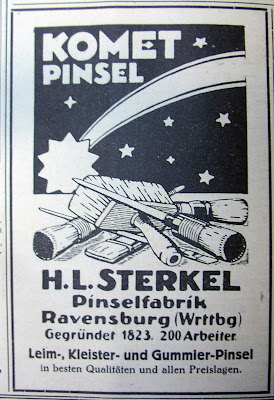 |
| In honor of the two comets we will have seen this year, an ad from a brush factory. |
 |
| A journeyman son of a meister looking to swap positions with a peer. Experienced in all manner of binding styles and no slouch in gold tooling and blocking. |
Monday, March 11, 2013
Georg Collin and an English view of German Bookbinding
From The Profession Of Bookselling: A Handbook Of Practical Hints For The Apprentice And Bookseller by A. Growoll, London, 1895. Pg 108.
Georg Collin is the father of Ernst Collin who wrote Der Pressbengel (The Bone Folder).
Georg Collin is the father of Ernst Collin who wrote Der Pressbengel (The Bone Folder).
Tuesday, January 1, 2013
The Bone Folder, con't (About stiffened paper bindings)
It has been some time since our Bibliophile and Bookbinder had their last conversation about bookbinding and the trade. In the spirit of Collin and his Bone Folder (Der Pressbengel) I continue that conversation to draw in some German binding styles not included in the original text but of that time. I invite you to join the conversation in the "comments" section below, too.
Several months later…
BOOKBINDER: Hello. What brings you back so soon? I haven’t even begun working on the books you dropped off after our last conversation about bookbinding. How is your book about our conversations coming along? Is it done yet? (chuckles)
BIBLIOPHILE: Don’t laugh. I’ve been working on it constantly and the more I do so the more questions I have. I had no idea there were so many facets to bookbinding and even art. As I was looking through some reference books at home and at the library I came across some bindings that you did not tell me about, perhaps because they are too common and beneath a binder of your reputation. Yet, as I was pondering them they struck me as perhaps the most honest in how they were made and are used.
BOOKBINDER: Really, this could be very interesting. Do you have examples with you?
BIBLIOPHILE: Not of both, but I do have an example of the smaller one in my coat pocket. It is very simple binding on a trade publication, comfortable to hold, not too delicate, unadorned, and very affordable. I have seen it used for school books, notebooks, address books and never really paid any attention to how they were made. But since our conversations I find myself critically looking at anything resembling a book. You have opened my eyes more than I could have imagined when we first met.
BOOKBINDER: Hmmm, yes that is a stiffened paper binding [Steifbroschure]. We, and by that I mean the trade, use it often for ephemeral items, or as an interim binding for something that book lovers like you might want to have bound properly. Although I am familiar with them and made one during my apprenticeship, it is not something I am interested in producing in my bindery – I usually refer them to a colleague who specialized in more modest, less expensive bindings. He also does work for some of the libraries in the area. I suppose they do have their place though.
BIBLIOPHILE: Tell me more about them so that I may understand your aversion to them. I could see them as a very useful binding for many books that may not be worthy of a fancier binding.
BOOKBINDER: Well, there are many reasons, but the main reason is that the structure is weaker and looks cheaper when compared to a “real” binding.
Often, especially for things that are to be rebound properly like a finely printed text, this minimal structure is appropriate in the short term, but what happens if it is never bound? If “holländern” [a very rudimentary form of sewing a text that originated in Holland [PDV1] is used the sewing is very weak and the only thing holding the text together is glue and a single thread. Then, we often use a very thin calico cloth that is glued directly to the spine to cover with everything else being paper. The cheapest ones may not even cover the thin boards – not a very durable combination. That may not matter, but why not bind the book properly from the beginning?
BIBLIOPHILE: As always Master you make good points, but what if I want to read the text and think about it before asking you to bind it. Wouldn’t it be better to have it protected at least that little bit?
BOOKBINDER: Perhaps… For the other types of “books” you mentioned such as school books, notebooks, address books it may well not matter much if they do not last. Still, there are simple ways we can use to make them stronger. We could, for example, sew them on tapes, and stiffen the boards with thin card. Perhaps one could even use a stronger cloth on the spine, perhaps with a nice decorated paper, or one could cover the whole book in cloth and just turn in at the fore-edges. But even then, why not bind properly?
BIBLIOPHILE: That is very interesting and gives me ideas. Still, I believe that you are right in saying that the binding is not very durable. That would also mean one shouldn’t use it for larger or heavier books. In that case I agree that one should just bind it properly to begin with. But, don’t you think that the style has its place in your selection of tools? I am trying to remember who it was, but I recently read in one of your trade publications that "'good enough’ is sometimes an appropriate, and even a noble goal, not an abomination.“ [PDV2] I think it was in the Allgemeiner Anzeiger für Buchbindereien. Don’t you think that might be the case with these unassuming bindings?
BOOKBINDER: I suppose you might be right, but there is a reason that these stiffened paper bindings are not described very often in our bookbinding manuals. Often one does not even need to know how to bind a book in order to make one. Even a printer could make one – a trade that often does not even understand the importance of grain direction.
Here, look at the example you brought. You can see that the endpaper is nothing more than a single leaf that has been hooked around the first signature. Then the sewing is very weak, the holländern I mentioned earlier. Then, the boards are only thin pieces of card like that used for file folders, how much protection can they offer. Also, the thin cloth is adhered directly to the spine. See how the cloth on the spine is starting to fray at the spine. It is not even turned in or reinforced as in the case of a proper binding. There are not even squares to protect the textblock like we have on even the most basic paper-covered case binding. Imagine what would happen if it was covered in nothing but a thin paper…
BIBLIOPHILE: I apologize if I am causing you distress, but I am very eager to learn and understand all I can about your beautiful craft and the trade. You have work to do, and I must go. I will try to stop by again soon with that other style of binding I wanted to learn about. Until then…
Several weeks later…
BIBLIOPHILE: Hello Master! Thank you for sending your apprentice over with the first of the books you bound for me. I am completely enamored with the delicate paper case bindings you made for my collection of poems. The pastepaper harmonizes beautifully with the delicate leather trim on the spine – headcaps you called them? – and the corners. Here is my payment. Unfortunately I was on my way out when he came by and couldn’t pay then.
BOOKBINDER: I am delighted that you are pleased with the binding. It is a style I truly love for its honest simplicity, especially when well done.
I’ve been thinking more about our earlier conversation – the one about those stiffened paper bindings. I was especially struck by your comment about something “good enough” being an appropriate goal. It is a very basic binding, one that is very easy and economical to make. That doesn’t mean it can’t be well made with almost the same amount of effort. When I was making a delivery to a very good client, a professor with a large library and many students, I noticed several books on a table that were bound in that way. Of the ones I saw that even the oldest one from the 1860s, a dissertation., It wasn’t pretty, thin cloth on the spine with boards undecorated except for the front of the wrapper that had been glued on, but had held up quite well with seemingly heavy use. Then I noticed others with marbled papers and other combinations of materials. I admit with a sense of chagrin that they have grown on me as an acceptable style of binding that I could see producing in my bindery. A nice economical alternative that could appeal to many who would like something very basic yet attractive. I will need to experiment so that I can discover the many variations that are possible. It would even be useful for my apprentices to learn. They even teach it in trade school now because of that Professor Adam (1849-1931) in Düsseldorf. He has spent a great part of his life trying to change how we train apprentices, and what they learn. It might even be something I could offer my clients in a more distinctive version. I do need to be careful about my reputation, especially in this economy.
BIBLIOPHILE: I’m sorry, but I must rush out. Next time I will remember to bring that other book I wanted to ask about. It’s rather strange style of binding – one I have not encountered before.
BOOKBINDER: Until then, and hopefully I will have finished some more of your books. I thank you for this conversation and making me challenge my assumptions.
 |
| From Marburg, Bildarchiv Foto Marburg |
Several months later…
BOOKBINDER: Hello. What brings you back so soon? I haven’t even begun working on the books you dropped off after our last conversation about bookbinding. How is your book about our conversations coming along? Is it done yet? (chuckles)
BIBLIOPHILE: Don’t laugh. I’ve been working on it constantly and the more I do so the more questions I have. I had no idea there were so many facets to bookbinding and even art. As I was looking through some reference books at home and at the library I came across some bindings that you did not tell me about, perhaps because they are too common and beneath a binder of your reputation. Yet, as I was pondering them they struck me as perhaps the most honest in how they were made and are used.
BOOKBINDER: Really, this could be very interesting. Do you have examples with you?
BIBLIOPHILE: Not of both, but I do have an example of the smaller one in my coat pocket. It is very simple binding on a trade publication, comfortable to hold, not too delicate, unadorned, and very affordable. I have seen it used for school books, notebooks, address books and never really paid any attention to how they were made. But since our conversations I find myself critically looking at anything resembling a book. You have opened my eyes more than I could have imagined when we first met.
BOOKBINDER: Hmmm, yes that is a stiffened paper binding [Steifbroschure]. We, and by that I mean the trade, use it often for ephemeral items, or as an interim binding for something that book lovers like you might want to have bound properly. Although I am familiar with them and made one during my apprenticeship, it is not something I am interested in producing in my bindery – I usually refer them to a colleague who specialized in more modest, less expensive bindings. He also does work for some of the libraries in the area. I suppose they do have their place though.
BIBLIOPHILE: Tell me more about them so that I may understand your aversion to them. I could see them as a very useful binding for many books that may not be worthy of a fancier binding.
BOOKBINDER: Well, there are many reasons, but the main reason is that the structure is weaker and looks cheaper when compared to a “real” binding.
Often, especially for things that are to be rebound properly like a finely printed text, this minimal structure is appropriate in the short term, but what happens if it is never bound? If “holländern” [a very rudimentary form of sewing a text that originated in Holland [PDV1] is used the sewing is very weak and the only thing holding the text together is glue and a single thread. Then, we often use a very thin calico cloth that is glued directly to the spine to cover with everything else being paper. The cheapest ones may not even cover the thin boards – not a very durable combination. That may not matter, but why not bind the book properly from the beginning?
BIBLIOPHILE: As always Master you make good points, but what if I want to read the text and think about it before asking you to bind it. Wouldn’t it be better to have it protected at least that little bit?
BOOKBINDER: Perhaps… For the other types of “books” you mentioned such as school books, notebooks, address books it may well not matter much if they do not last. Still, there are simple ways we can use to make them stronger. We could, for example, sew them on tapes, and stiffen the boards with thin card. Perhaps one could even use a stronger cloth on the spine, perhaps with a nice decorated paper, or one could cover the whole book in cloth and just turn in at the fore-edges. But even then, why not bind properly?
BIBLIOPHILE: That is very interesting and gives me ideas. Still, I believe that you are right in saying that the binding is not very durable. That would also mean one shouldn’t use it for larger or heavier books. In that case I agree that one should just bind it properly to begin with. But, don’t you think that the style has its place in your selection of tools? I am trying to remember who it was, but I recently read in one of your trade publications that "'good enough’ is sometimes an appropriate, and even a noble goal, not an abomination.“ [PDV2] I think it was in the Allgemeiner Anzeiger für Buchbindereien. Don’t you think that might be the case with these unassuming bindings?
BOOKBINDER: I suppose you might be right, but there is a reason that these stiffened paper bindings are not described very often in our bookbinding manuals. Often one does not even need to know how to bind a book in order to make one. Even a printer could make one – a trade that often does not even understand the importance of grain direction.
Here, look at the example you brought. You can see that the endpaper is nothing more than a single leaf that has been hooked around the first signature. Then the sewing is very weak, the holländern I mentioned earlier. Then, the boards are only thin pieces of card like that used for file folders, how much protection can they offer. Also, the thin cloth is adhered directly to the spine. See how the cloth on the spine is starting to fray at the spine. It is not even turned in or reinforced as in the case of a proper binding. There are not even squares to protect the textblock like we have on even the most basic paper-covered case binding. Imagine what would happen if it was covered in nothing but a thin paper…
BIBLIOPHILE: I apologize if I am causing you distress, but I am very eager to learn and understand all I can about your beautiful craft and the trade. You have work to do, and I must go. I will try to stop by again soon with that other style of binding I wanted to learn about. Until then…
Several weeks later…
BIBLIOPHILE: Hello Master! Thank you for sending your apprentice over with the first of the books you bound for me. I am completely enamored with the delicate paper case bindings you made for my collection of poems. The pastepaper harmonizes beautifully with the delicate leather trim on the spine – headcaps you called them? – and the corners. Here is my payment. Unfortunately I was on my way out when he came by and couldn’t pay then.
BOOKBINDER: I am delighted that you are pleased with the binding. It is a style I truly love for its honest simplicity, especially when well done.
I’ve been thinking more about our earlier conversation – the one about those stiffened paper bindings. I was especially struck by your comment about something “good enough” being an appropriate goal. It is a very basic binding, one that is very easy and economical to make. That doesn’t mean it can’t be well made with almost the same amount of effort. When I was making a delivery to a very good client, a professor with a large library and many students, I noticed several books on a table that were bound in that way. Of the ones I saw that even the oldest one from the 1860s, a dissertation., It wasn’t pretty, thin cloth on the spine with boards undecorated except for the front of the wrapper that had been glued on, but had held up quite well with seemingly heavy use. Then I noticed others with marbled papers and other combinations of materials. I admit with a sense of chagrin that they have grown on me as an acceptable style of binding that I could see producing in my bindery. A nice economical alternative that could appeal to many who would like something very basic yet attractive. I will need to experiment so that I can discover the many variations that are possible. It would even be useful for my apprentices to learn. They even teach it in trade school now because of that Professor Adam (1849-1931) in Düsseldorf. He has spent a great part of his life trying to change how we train apprentices, and what they learn. It might even be something I could offer my clients in a more distinctive version. I do need to be careful about my reputation, especially in this economy.
BIBLIOPHILE: I’m sorry, but I must rush out. Next time I will remember to bring that other book I wanted to ask about. It’s rather strange style of binding – one I have not encountered before.
BOOKBINDER: Until then, and hopefully I will have finished some more of your books. I thank you for this conversation and making me challenge my assumptions.
- [PDV1] Ludwig Brade, Emil Winkler, Das illustrierte Buchbinderbuch heißt es im 23. Abschnitt über Broschüren: "Durch das Heften der Broschüren bezweckt man die inneren Lagen der Bogen beim Aufschneiden derselben fest zu halten, damit sie nicht herausfallen, deshalb wird es so einfach als möglich ausgeführt und zwar auf die Art, welche man holländern nennt. Diese Bezeichnung hat ihren Ursprung darin, daß man jene Heftart zuerst in Holland anwendete und sie später auch in andere Länder überging.
- [PDV2] Karen Hanmer in an email to the author about this binding style. 4/26/2012.
Wednesday, December 12, 2012
A German View of English Bookbinding
From The British Bookmaker, Vol V., 1891-92.
An English, French, and German bookbinder meet in a bar... Often contentious, yet unavoidably fun at bookbinding conferences among the older generations. The youngsters just shake their heads... Here are the German's thoughts on English binding. It should be remembered that a great number of Germans emigrated to England to work as binders making this more interesting.
An English, French, and German bookbinder meet in a bar... Often contentious, yet unavoidably fun at bookbinding conferences among the older generations. The youngsters just shake their heads... Here are the German's thoughts on English binding. It should be remembered that a great number of Germans emigrated to England to work as binders making this more interesting.
 |
| Click to Enlarge and Read |
From this we see that the English book is remarkable for its durability, but of decorative style and taste there is a complete absence. Clumsy are the stamps and poor are the designs in a style not worthy of mention, but the national pride of the Englishman keeps him from studying the work of other nations, either to benefit by it or even to copy it, except a few old historic and well-known originals: they have a chance of being copied, but even in the styles of Roger Payne or Harley they use massive ornaments that require very cleverly putting together to make a tasteful ensemble.
All of this is debatable, so get a beer and sit back. I'd love to hear what the British of the same era think of the Germans, what the French think... Attitudes haven't changed all that much.
When it comes to design/fine binding, my interests really begin in the 20th century with a preference for German vellum and paper case-bindings (especially with pastepapers), and anything French art-deco. In leather design/fine bindings the French aesthetic just can't be beat. Just plain elegant (with the leather too thin...) and mind blowing. The Germans with typographic designs are also hard to beat, but their structures are a bit more Teutonicly robust. For utilitarian, everyday binding the German case in cloth or paper is it.
What are your opinions of the various national traditions?
Tuesday, June 26, 2012
German Stiffened Paper Bindings - 2
That there was once the idea that books were functional items, not fetishized objects that should take as long as possible to make and should include many unnecessary features.
That "good enough" is sometimes an appropriate, and even a noble goal, not an abomination.
Karen Hanmer (4/26/2012)
Known as broschuren and steifbroschuren in German, these brochures, pamphlets, and other related bindings have long been a part of the German bookbinding tradition. These can range from single section pamphlets with simple wrappers to adhesive bound or sewn textblocks in wrappers, to hard cover variants. In all cases the common thread is providing the texts with a simple yet functional binding that may or may not be intended to be permanent.
In my previous post I provided some images of historical examples of this structure from Syracuse University Library's von Ranke collection. In this post I will provide a more tutorial-like description (a more formal article is in preparation) of some of the variations that are common.
The textblock I have used is my translation of Collin's Der Pressbengel available as The Bone Folder in a pdf version laid out in signatures. See the link in the left side bar to download. As was, and remains, common to most books, the letter-sized paper I used has the grain running perpendicular to the spine resulting in some cockling of the textblock due to moisture from the adhesive used to attach the boards and covering... There, got that out of the way.
Forwarding of these is very minimal, endsheets generally a single sheet or folio that is folded/hooked around the first and last signature or a simply a tipped on folio.
Historically, sewing was generally a simple unsupported stitch (Holländern). Several books would be sewn together in stacks and then separated into the individual volumes by cutting the threads between after the pasting/gluing up of the spines. Staples were also common in lieu of sewing with thread. After being separated, the spines were repasted/glued and inserted into a folded paper wrapper. In some cases the wrapper was also pasted to the endsheet to make a slightly stiffer cover.
 |
| Detail from Stitches and Sewings for Bookbinding Structures by Betsy Palmer Eldridge. Presented at the Guild of Book Workers Standards of Excellence, October 2008 |
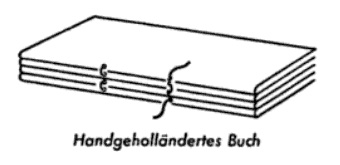 |
| Detail from Wiese's Der Bucheinband. |
In the variant with stiff boards, endpapers were identical, with a single tipped on folio also being used, especially in the 20th century. Sewing was often more robust using a linked stitch, but also tapes, slips, or recessed cords being used. After sewing, the spine was pasted/glued as before. The book could also be rounded but was not backed to save a step.
Next thin boards were cut to the height of the textblock, with a width that allowed for a narrow “groove” and for edge square. The top/bottom endsheets are pasted/glued out, the boards positioned and the book given a quick nip in the press. The book would then be covered with full paper, cloth on spine and paper on boards, or full cloth. Cloth would generally be thinner, and was not turned in, except occasionally at fore edge. Next, all three edges were trimmed flush unless a fore-edge square was left, in which case only top and bottom were trimmed. Finally a label could be applied.
Steps that follow will describe several variants that can be applied to sewn and adhesive bound structures using soft and stiff boards (Steifbroschuren).
Adhesive bound:
I use this style to bind text printed out from Google Books, books that arrived with spiral-type bindings, or simple substantial photocopied articles... Not beautiful but very functional.
Cut single folio endsheets to fit textblock. Precut thin cloth/muslin to height of textblock and ca 6cm wider than spine. Put endsheets on both sides of textblock and double-fan adhesive bind applying thin cloth centered on spine ensuring that it is well adhered with glue seeping through. Put in press with boards just shy of spine edge and close press tightly.
When dry, cut boards proportionate in thickness to the size of the book to the height and width of the textblock. To attach boards apply adhesive first to the outer sheet, put down cloth hinge, apply adhesive over cloth (all as if casing in) and then put down first board, setting it back from the spine by about 5 millimeters. Repeat with other side. Insert fences of thin cardstock between pastedowns and text, and put in press giving it a good hard nip.
To cover, cut cloth to cover spine and reaching onto board (or fully cover spine and both boards). Work cloth into groove ensuring good adhesion to spine, then onto remaining board. Using edged casing-in boards give quick nip, take out. If only spine was covered, leave remaining board bare or cover with a contrasting paper or cloth.
If a fore-edge square is left, trim this to the desired size before covering, cover, trim so that it is no more than a centimeter, and then turn-in.Put between boards and under weight to dry.
Trim 3 sides so as to be flush, i.e. no squares. If a fore-edge square was left, trim only at head and tail.
Apply label to spine of front board as/if desired.
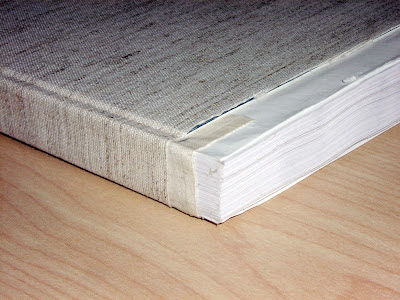 |
| Adhesive bound before trimming showing layers. |
 |
| Adhesive bound after trimming |
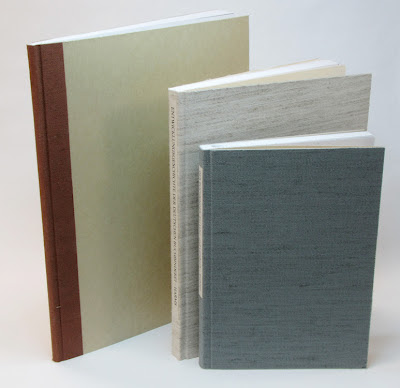 |
| A selection of adhesive bound volumes. At left only spine covered with bare boards. |
Simple unsupported stitch (geholländert):
Sewn using the very basic unsupported stitch described above is historical and not something I would apply to a binding that will be used. An unsupported linked stitch will work much better.
Sew textblock using an unsupported linked stitch with a single-folio endsheet hooked around the first and last signatures. This will become the pastedown. After sewing square up and glue up spine.
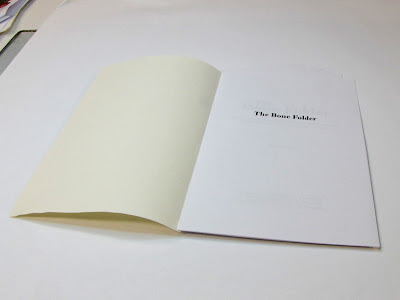 |
| Single leave hooked around first signature prior to sewing. |
 |
| Sewing completed, but not yet glued up. Image shows how signatures are only connected with each other at one point with two stations total. See earlier diagrams above for more detail. |
When dry, cut thin boards proportionate in thickness to the size of the book to the height and width of the textblock. To attach boards apply adhesive first to the outer sheet and then put down first board, setting it back from the spine by about 5 millimeters. Repeat with other side. Insert fences of thin cardstock between pastedowns and text, and put in press giving it a good hard nip.
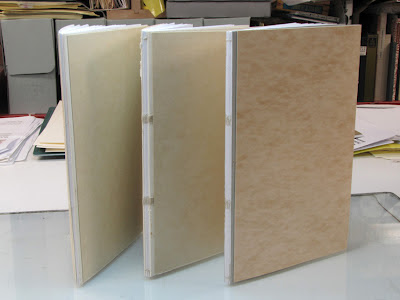 |
| Boards attached after sewing From left: Simple unsupported; sewn on tapes; unsupported link stitch. |
To cover, cut paper or cloth to cover spine and reaching onto board (or fully cover spine and both boards). Work material into groove ensuring good adhesion to spine (there should be no "hollow"). If only spine was covered, leave remaining board bare or cover with a contrasting paper or cloth.
If a fore-edge square is left, trim this to the desired size before covering, cover, trim so that it is no more than a centimeter, and then turn-in. Put between boards and under weight to dry.
Trim 3 sides so as to be flush, i.e. no squares. If a fore-edge square was left, trim only at head and tail.
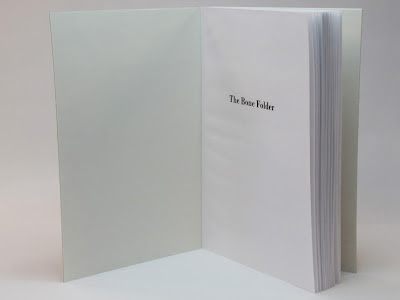 |
| Interior view after trimming. |
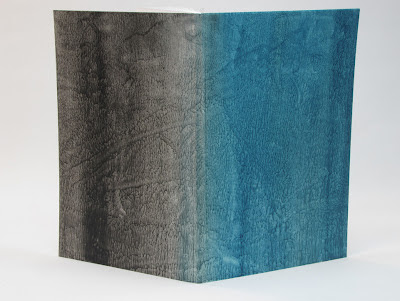 |
| Exterior view after trimming. |
Apply label to spine of front board as/if desired.
Folio endsheet hooked around first and last signatures and sewn on tapes:
Sew textblock on tapes with using a double-folio endsheet section that is hooked around the first and last signatures. After sewing glue up spine.
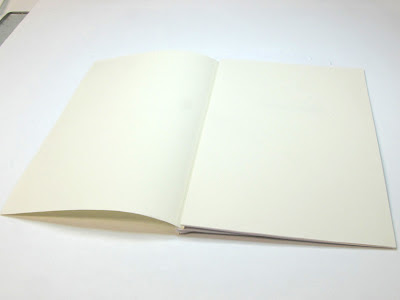 |
| Single folio hooked around first signature prior to sewing. |
When dry, cut thin boards proportionate in thickness to the size of the book to the height and width of the textblock. To attach boards apply adhesive first to the outer sheet and then put down first board, setting it back from the spine by about 5 millimeters. Repeat with other side. Insert fences of thin cardstock between pastedowns and text, and put in press giving it a good hard nip. [See earlier image above]
To cover, cut paper or cloth to cover spine and reaching onto board (or fully cover spine and both boards). Work material into groove ensuring good adhesion to spine (there should be no "hollow"). If only spine was covered, leave remaining board bare or cover with a contrasting paper or cloth.
If a fore-edge square is left, trim this to the desired size before covering, cover, trim so that it is no more than a centimeter, and then turn-in. Put between boards and under weight to dry.
Trim 3 sides so as to be flush, i.e. no squares. If a fore-edge square was left, trim only at head and tail.
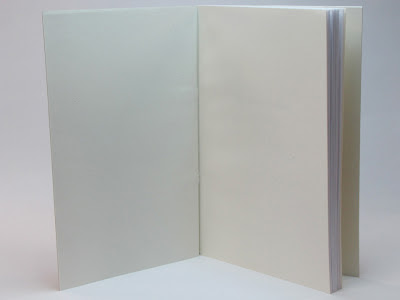 |
| Interior view after trimming. Note tapes under pastedown. |
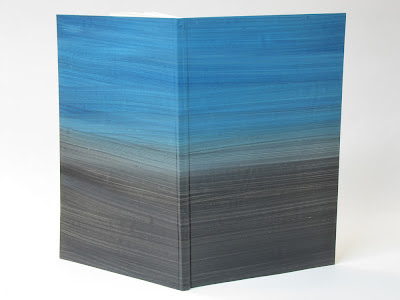 |
| Exterior view after trimming. |
Apply label to spine of front board as/if desired.
Spine covered separately with fore-edge squares:
For these these last two books, I used a single folio endsheet tipped-onto the first and last signatures. Sewing was with an unsupported linked stitch. After sewing the textblock was glued up.
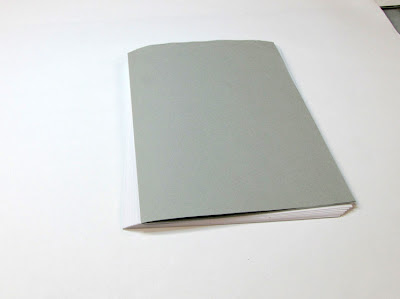 |
| Single folio tipped-on endsheet. |
When dry, cut thin boards proportionate in thickness to the size of the book to the height and width of the textblock. To attach boards apply adhesive first to the outer sheet and then put down first board, setting it back from the spine by about 5 millimeters. Repeat with other side. Insert fences of thin cardstock between pastedowns and text, and put in press giving it a good hard nip. [See earlier image above]
Trim at head and tail only and trim fore-edge square to desired size.
Images below show variant in which the spine with spine stiffener was applied first leaving a hollow. In addition the spine was lined with muslin to offer more support.
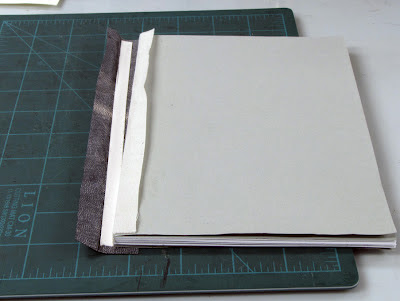 |
| Spine lined and (leather) covered stiffener ready. |
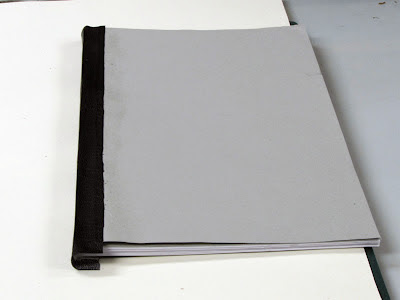 |
| Spine-stiffener attached to endsheets. |
To cover, cut paper or cloth to cover spine and reaching onto board (or fully cover spine and both boards). Work material into groove ensuring good adhesion to spine (there should be no "hollow"). If only spine was covered, leave remaining board bare or cover with a contrasting paper or cloth.
 |
| Spine covered in cloth with paper sides. Fore-edge square left with paper turned-in around. |
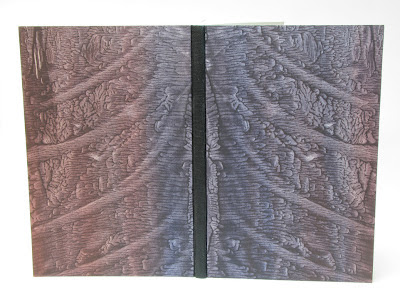 |
| Spine covered with leather before applying boards. Boards covered with paper turned in at spine edge, fore-edge square left with paper turned-in around. |
If a fore-edge square is left, trim this to the desired size before covering, cover, trim so that it is no more than a centimeter, and then turn-in. Put between boards and under weight to dry.
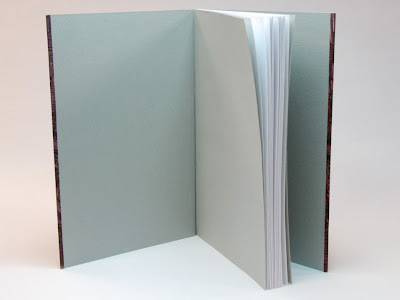 |
| Interior view showing turn-in at fore-edge. |
Trim 3 sides so as to be flush, i.e. no squares. If a fore-edge square was left, trim only at head and tail.
Apply label to spine of front board as/if desired.
The finished books:
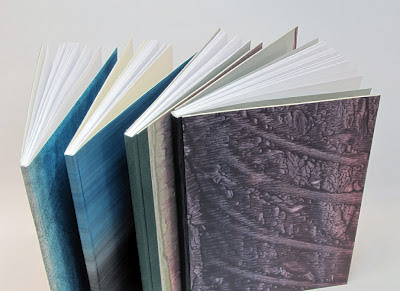 | |
| Note thickness of the boards. Two on the left use 20pt folder stock. Two on right 25pt pressboard which is stiffer than the folder stock. |
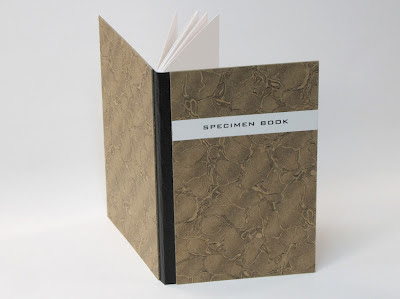 |
| Specimen Book by Barbara Tetenbaum uses this structure. |
Notes:
While the images above show 4 distinct models, this structure is very modular and can be elements can be easily moved around. It can also be used for single signature items.
Have fun and experiment.
Related resources:
Books: All titles in German but most with good diagrams...
- Adam, Paul. Title: Die praktischen Arbeiten des Buchbinders. Wien: A. Hartleben's Verlag, 1898.
- Published in English as Practical Bookbinding, London: Scott, Greenwood & Co., 1903.
- Henningsen, Thorwald. Handbuch für den Buchbinder. St. Gallen: Rudolf Hostettler Verlag, 1969.
- L. Brades illustriertes Buchbinderbuch: Ein Lehr- und Handbuch der gesamten Buchbinderei und aller in dieses Fach eingeschlagenden Techniken. Halle: Verlag von Wilhelm Knapp, 1921.
- Lüers, Heinrich. Das Fachwissen des Buchbinder. Stuttgart: Max Hettler Verlag 1943.
- Moessner, Gustav. Die täglichen Buchbinderarbeiten: Eine Unterweisung in den einfachen Arbeiten der Buchbinderei. Stuttgart: Max Hettler Verlag, 1969.
- Rhein, Adolf. Das Buchbinderbuch. Halle (Saale): VEB Wilhelm Knapp Verlag, 1953.
- Wiese, Fritz. Der Bucheinband: Eine Arbeitskunde mit Werkszeichnungen. Hannover: Schlüterische Verlagsanstalt und Druckerei, 1983.
- Zahn, Gerhard. Grundwissen für Buchbinder: Schwerpunkt Einzelfertigung.Itzehoe: Verlage Beruf + Schule, 1990.
Examples of these and other variants. In German, but with lots of diagrams.
Subscribe to:
Posts (Atom)








.jpg)
.jpg)
.jpg)
.jpg)
.jpg)
.jpg)
.jpg)
.jpg)


